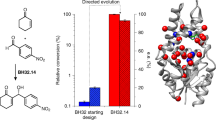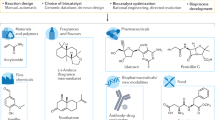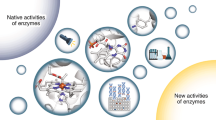Abstract
Enzymes play an increasingly important role in improving the benignity and efficiency of chemical production, yet the diversity of their applications lags heavily behind chemical catalysts as a result of the relatively narrow range of reaction mechanisms of enzymes. The creation of enzymes containing non-biological functionalities facilitates reaction mechanisms outside nature’s canon and paves the way towards fully programmable biocatalysis1,2,3. Here we present a completely genetically encoded boronic-acid-containing designer enzyme with organocatalytic reactivity not achievable with natural or engineered biocatalysts4,5. This boron enzyme catalyses the kinetic resolution of hydroxyketones by oxime formation, in which crucial interactions with the protein scaffold assist in the catalysis. A directed evolution campaign led to a variant with natural-enzyme-like enantioselectivities for several different substrates. The unique activation mode of the boron enzyme was confirmed using X-ray crystallography, high-resolution mass spectrometry (HRMS) and 11B NMR spectroscopy. Our study demonstrates that genetic-code expansion can be used to create evolvable enantioselective enzymes that rely on xenobiotic catalytic moieties such as boronic acids and access reaction mechanisms not reachable through catalytic promiscuity of natural or engineered enzymes.
This is a preview of subscription content, access via your institution
Access options
Access Nature and 54 other Nature Portfolio journals
Get Nature+, our best-value online-access subscription
$29.99 / 30 days
cancel any time
Subscribe to this journal
Receive 51 print issues and online access
$199.00 per year
only $3.90 per issue
Buy this article
- Purchase on Springer Link
- Instant access to full article PDF
Prices may be subject to local taxes which are calculated during checkout




Similar content being viewed by others
Data availability
All data are available in the main text or the Supplementary Information. The crystallographic data for the structures of BOS and BOS_EHL have been deposited in the Protein Data Bank with accession numbers 8QDF and 8QDH, respectively. Source data are provided with this paper.
References
Leveson-Gower, R. B., Mayer, C. & Roelfes, G. The importance of catalytic promiscuity for enzyme design and evolution. Nat. Rev. Chem. 3, 687–705 (2019).
Chen, K. & Arnold, F. H. Engineering new catalytic activities in enzymes. Nat. Catal. 3, 203–213 (2020).
Lovelock, S. L. et al. The road to fully programmable protein catalysis. Nature 606, 49–58 (2022).
Hall, D. G. Boronic acid catalysis. Chem. Soc. Rev. 48, 3475–3496 (2019).
Drienovská, I. & Roelfes, G. Expanding the enzyme universe with genetically encoded unnatural amino acids. Nat. Catal. 3, 193–202 (2020).
Dembitsky, V. M., Al Quntar, A. A. & Srebnik, M. Natural and synthetic small boron-containing molecules as potential inhibitors of bacterial and fungal quorum sensing. Chem. Rev. 111, 209–237 (2011).
Miyaura, N. & Suzuki, A. Palladium-catalyzed cross-coupling reactions of organoboron compounds. Chem. Rev. 95, 2457–2483 (1995).
Diaz, D. B. & Yudin, A. K. The versatility of boron in biological target engagement. Nat. Chem. 9, 731–742 (2017).
Ishihara, K. & Yamamoto, H. Arylboron compounds as acid catalysts in organic synthetic transformations. Eur. J. Org. Chem. 1999, 527–538 (1999).
Zhang, S., Lebœuf, D. & Moran, J. Brønsted acid and H-bond activation in boronic acid catalysis. Chem. Eur. J. 26, 9883–9888 (2020).
Graham, B. J. & Raines, R. T. Emergent organoboron acid catalysts. J. Org. Chem. 89, 2069–2089 (2024).
Adonin, N. Y. & Bardin, V. V. Polyfluorinated arylboranes as catalysts in organic synthesis. Mendeleev Commun. 30, 262–272 (2020).
Ishihara, K., Ohara, S. & Yamamoto, H. 3,4,5-Trifluorobenzeneboronic acid as an extremely active amidation catalyst. J. Org. Chem. 61, 4196–4197 (1996).
Al-Zoubi, R. M., Marion, O. & Hall, D. G. Direct and waste-free amidations and cycloadditions by organocatalytic activation of carboxylic acids at room temperature. Angew. Chem. Int. Ed. 47, 2876–2879 (2008).
Zheng, H., Ghanbari, S., Nakamura, S. & Hall, D. G. Boronic acid catalysis as a mild and versatile strategy for direct carbo- and heterocyclizations of free allylic alcohols. Angew. Chem. Int. Ed. 51, 6187–6190 (2012).
Estopiñá-Durán, S. et al. Aryl boronic acid catalysed dehydrative substitution of benzylic alcohols for C–O bond formation. Chem. Eur. J. 25, 3950–3956 (2019).
Hayama, N., Azuma, T., Kobayashi, Y. & Takemoto, Y. Chiral integrated catalysts composed of bifunctional thiourea and arylboronic acid: asymmetric aza-Michael addition of α,β-unsaturated carboxylic acids. Chem. Pharm. Bull. 64, 704–717 (2016).
Hayama, N., Kobayashi, Y. & Takemoto, Y. Asymmetric hetero-Michael addition to α,β-unsaturated carboxylic acids using thiourea–boronic acid hybrid catalysts. Tetrahedron 89, 132089 (2021).
Arnold, K., Davies, B., Hérault, D. & Whiting, A. Asymmetric direct amide synthesis by kinetic amine resolution: a chiral bifunctional aminoboronic acid catalyzed reaction between a racemic amine and an achiral carboxylic acid. Angew. Chem. Int. Ed. 47, 2673–2676 (2008).
Arnold, K. et al. The first example of enamine–Lewis acid cooperative bifunctional catalysis: application to the asymmetric aldol reaction. Chem. Comm. https://doi.org/10.1039/B806779A (2008).
Azuma, T., Murata, A., Kobayashi, Y., Inokuma, T. & Takemoto, Y. A dual arylboronic acid–aminothiourea catalytic system for the asymmetric intramolecular hetero-Michael reaction of α,β-unsaturated carboxylic acids. Org. Lett. 16, 4256–4259 (2014).
Mo, X. & Hall, D. G. Dual catalysis using boronic acid and chiral amine: acyclic quaternary carbons via enantioselective alkylation of branched aldehydes with allylic alcohols. J. Am. Chem. Soc. 138, 10762–10765 (2016).
Hashimoto, T., Gálvez, A. O. & Maruoka, K. Boronic acid-catalyzed, highly enantioselective aza-Michael additions of hydroxamic acid to quinone imine ketals. J. Am. Chem. Soc. 137, 16016–16019 (2015).
Hall, D. G. in Boronic Acids (ed. Hall, D. G.) 1–133 (Wiley, 2005).
Brustad, E. et al. A genetically encoded boronate-containing amino acid. Angew. Chem. Int. Ed. 47, 8220–8223 (2008).
Akgun, B. & Hall, D. G. Boronic acids as bioorthogonal probes for site-selective labeling of proteins. Angew. Chem. Int. Ed. 57, 13028–13044 (2018).
Chatterjee, S., Anslyn, E. V. & Bandyopadhyay, A. Boronic acid based dynamic click chemistry: recent advances and emergent applications. Chem. Sci. 12, 1585–1599 (2021).
Birch-Price, Z., Taylor, C. J., Ortmayer, M. & Green, A. P. Engineering enzyme activity using an expanded amino acid alphabet. Protein Eng. Des. Sel. 36, gzac013 (2023).
Drienovská, I., Mayer, C., Dulson, C. & Roelfes, G. A designer enzyme for hydrazone and oxime formation featuring an unnatural catalytic aniline residue. Nat. Chem. 10, 946–952 (2018).
Zhou, Z. & Roelfes, G. Synergistic catalysis in an artificial enzyme by simultaneous action of two abiological catalytic sites. Nat. Catal. 3, 289–294 (2020).
Burke, A. J. et al. Design and evolution of an enzyme with a non-canonical organocatalytic mechanism. Nature 570, 219–223 (2019).
Trimble, J. S. et al. A designed photoenzyme for enantioselective [2+2] cycloadditions. Nature 611, 709–714 (2022).
Sun, N. et al. Enantioselective [2+2]-cycloadditions with triplet photoenzymes. Nature 611, 715–720 (2022).
Gefflaut, T., Blonski, C., Perie, J. & Willson, M. Class I aldolases: substrate specificity, mechanism, inhibitors and structural aspects. Prog. Biophys. Mol. Biol. 63, 301–340 (1995).
O’Hagan, D. & Schmidberger, J. W. Enzymes that catalyse SN2 reaction mechanisms. Nat. Prod. Rep. 27, 900–918 (2010).
Gabruk, M. & Mysliwa-Kurdziel, B. Light-dependent protochlorophyllide oxidoreductase: phylogeny, regulation, and catalytic properties. Biochemistry 54, 5255–5262 (2015).
Sorigué, D. et al. Mechanism and dynamics of fatty acid photodecarboxylase. Science 372, eabd5687 (2021).
Agustiandari, H., Lubelski, J., Saparoea, H. B. V. D. B. V., Kuipers, O. P. & Driessen, A. J. M. LmrR is a transcriptional repressor of expression of the multidrug ABC transporter LmrCD in Lactococcus lactis. J. Bacteriol. 190, 759–763 (2008).
Roelfes, G. LmrR: a privileged scaffold for artificial metalloenzymes. Acc. Chem. Res. 52, 545–556 (2019).
Drienovská, I., Scheele, R. A., Gutiérrez de Souza, C. & Roelfes, G. A hydroxyquinoline-based unnatural amino acid for the design of novel artificial metalloenzymes. ChemBioChem 21, 3077–3081 (2020).
Leveson-Gower, R. B., Zhou, Z., Drienovská, I. & Roelfes, G. Unlocking iminium catalysis in artificial enzymes to create a Friedel–Crafts alkylase. ACS Catal. 11, 6763–6770 (2021).
Simionatto, E. L., Yunes, P. R. & Yunes, R. A. The effect of boric acid on the dehydration step in the formation of oxime from salicylaldehyde. J. Chem. Soc. Perkin Trans. 2 https://doi.org/10.1039/P29930001291 (1993).
Hentschel, F. & Lindel, T. Synthesis of oximinotyrosine-derived marine natural products. Synthesis 2010, 181–204 (2010).
Bhalla, T. C., Kumar, V. & Kumar, V. Enzymes of aldoxime–nitrile pathway for organic synthesis. Rev. Environ. Sci. Biotechnol. 17, 229–239 (2018).
Minas, H. A. et al. Modular oxime formation by a trans-AT polyketide synthase. Angew. Chem. Int. Ed. 62, e202304481 (2023).
Hiroaki, N., Tadashi, O. & Takayuki, F. Hydrolysis of N-salicylidene-2-methoxyethylamine. Intramolecular general base catalysis and specific effects of boric acid. Bull. Chem. Soc. Jpn. 57, 2502–2507 (1984).
Gillingham, D. The role of boronic acids in accelerating condensation reactions of α-effect amines with carbonyls. Org. Biomol. Chem. 14, 7606–7609 (2016).
Madoori, P. K., Agustiandari, H., Driessen, A. J. M. & Thunnissen, A.-M. W. H. Structure of the transcriptional regulator LmrR and its mechanism of multidrug recognition. EMBO J. 28, 156–166 (2009).
Faber, K. in Biotransformations in Organic Chemistry: A Textbook 31–313 (Springer, 2011).
de Vries, R. H., Viel, J. H., Kuipers, O. P. & Roelfes, G. Rapid and selective chemical editing of ribosomally synthesized and post-translationally modified peptides (RiPPs) via CuII-catalyzed β-borylation of dehydroamino acids. Angew. Chem. Int. Ed. 60, 3946–3950 (2021).
Tsilikounas, E., Kettner, C. A. & Bachovchin, W. W. Boron-11 NMR spectroscopy of peptide boronic acid inhibitor complexes of .alpha.-lytic protease. Direct evidence for tetrahedral boron in both boron-histidine and boron-serine adduct complexes. Biochemistry 32, 12651–12655 (1993).
Macho, J. M., Blue, R. M., Lee, H.-W. & MacMillan, J. B. Boron NMR as a method to screen natural product libraries for B-containing compounds. Org. Lett. 24, 3161–3166 (2022).
Valenzuela, S. A., Howard, J. R., Park, H. M., Darbha, S. & Anslyn, E. V. 11B NMR spectroscopy: structural analysis of the acidity and reactivity of phenyl boronic acid–diol condensations. J. Org. Chem. 87, 15071–15076 (2022).
Barsoum, D. N., Kirinda, V. C., Kang, B. & Kalow, J. A. Remote-controlled exchange rates by photoswitchable internal catalysis of dynamic covalent bonds. J. Am. Chem. Soc. 144, 10168–10173 (2022).
Acknowledgements
We thank J. Kemmink, P. van der Meulen and J. Hekelaar for analytical support. We also thank I. Drienovská for the preparation of some of the plasmids used in this work. This work was supported by The Netherlands Ministry of Education, Culture and Science (Gravitation programme no. 024.001.035) and the European Research Council (ERC advanced grant 885396). L.L. acknowledges the support of the Leopoldina - National Academy of Sciences for a postdoctoral fellowship (LPDS 2021-11). The European Synchrotron Radiation Facility (ESRF) is acknowledged for provision of synchrotron radiation facilities and we are grateful to M. Bowler, D. Flot and D. Nurizzo for their assistance and support in using ESRF beamline MASSIF-1.
Author information
Authors and Affiliations
Contributions
L.L., R.B.L.-G. and G.R. conceived the project. L.L. developed, optimized and performed the scope of the kinetic resolution reaction. R.B.L.-G. expressed designer enzymes and performed the evolution campaign. H.J.R. performed crystal-growing experiments. A.-M.W.H.T. analysed the X-ray data. G.R. directed the project. All authors discussed the results and L.L., R.B.L.-G. and G.R. wrote the manuscript.
Corresponding author
Ethics declarations
Competing interests
The authors declare no competing interests.
Peer review
Peer review information
Nature thanks James Taylor and the other, anonymous, reviewer(s) for their contribution to the peer review of this work. Peer reviewer reports are available.
Additional information
Publisher’s note Springer Nature remains neutral with regard to jurisdictional claims in published maps and institutional affiliations.
Extended data figures and tables
Extended Data Fig. 1 96-well UV/Vis plate assay results from the first round of directed evolution.
Top left, amino-acid positions chosen for saturation mutagenesis with β-carbons visualized as spheres. Top right, colour scale for rate of (R)-benzoin consumption observed in the lysates. Bottom, rate of benzoin consumption observed in 96-well-format lysates for the library members, screened in quadruplet. Some mutants were not produced owing to unsuccessful QuikChange reactions; these are labelled in grey. Two colonies of F93D were accidentally picked into positions intended for F93E, and so four more colonies were picked into otherwise blank wells.
Extended Data Fig. 2 96-well UV/Vis plate assay results from the second round of directed evolution.
Top left, amino-acid positions chosen for saturation mutagenesis with β-carbons visualized as spheres. Second-round positions are in green and the position of the first-round hit is in orange. Top right, colour scale for rate of (R)-benzoin consumption observed in the lysates. Bottom, rate of benzoin consumption observed in 96-well-format lysates for the library members, screened in quadruplet. Some mutants were not produced owing to unsuccessful QuikChange reactions; these are labelled in grey.
Extended Data Fig. 3 96-well UV/Vis plate assay results from the third round of directed evolution.
Top left, amino-acid positions chosen for saturation mutagenesis with β-carbons visualized as spheres (magenta). Positions of mutations in the template incorporated from the first and second rounds are shown in orange and green, respectively. Top right, colour scale for rate of (R)-benzoin consumption observed in the lysates. Bottom, rate of benzoin consumption observed in 96-well-format lysates for the library members, screened in quadruplet. Some mutants were not produced owing to unsuccessful QuikChange reactions; these are labelled in grey.
Extended Data Fig. 4 Structural features of BOS (PDB: 8QDF, purple) compared with wild-type LmrR (PDB: 3F8B, grey).
Top, overlay of the two structures shown in cartoon representation, with key residues N19, W96 and M89pBoF shown as sticks. BOS features a large reduction in the distance between the centres of the aromatic rings of the two central tryptophans from 7.2 Å in wild-type LmrR to 4.9 Å. Bottom, surface representation of the two structures showing that BOS features a closed pore, compared with the large open pore found in wild-type LmrR.
Extended Data Fig. 5 Effect of the N19A mutation on cyclic-boronate ester formation observed by 11B NMR.
Comparison of the 11B NMR spectra of BOS and BOS_N19A in phosphate buffer (a,b) and Tris buffer (c,d).
Extended Data Fig. 6 11B NMR spectra of BOS and BOS_N19A in the presence of a strong diol binder (4-nitrocatechol).
Comparison of interaction with 4-nitrocatechol of BOS (a) and BOS_N19A (b).
Extended Data Fig. 7 Structure of the improved variant BOS_EHL (PDB: 8QDH) compared with the parent BOS (PDB: 8QDF).
a, Complete overlay shows minimal changes in the overall structure with a partially collapsed pocket compared with wild-type LmrR (for example, PDB: 3F8B in the ligand-free state, not shown). b, Detailed view of an overlay of the catalytic pocket showing the interactions of N19 as well as the mutations at positions 8, 92 and 93. For clarity, only one of the two modelled binding modes of Tris is shown.
Supplementary information
Source data
Rights and permissions
Springer Nature or its licensor (e.g. a society or other partner) holds exclusive rights to this article under a publishing agreement with the author(s) or other rightsholder(s); author self-archiving of the accepted manuscript version of this article is solely governed by the terms of such publishing agreement and applicable law.
About this article
Cite this article
Longwitz, L., Leveson-Gower, R.B., Rozeboom, H.J. et al. Boron catalysis in a designer enzyme. Nature (2024). https://doi.org/10.1038/s41586-024-07391-3
Received:
Accepted:
Published:
DOI: https://doi.org/10.1038/s41586-024-07391-3
Comments
By submitting a comment you agree to abide by our Terms and Community Guidelines. If you find something abusive or that does not comply with our terms or guidelines please flag it as inappropriate.



